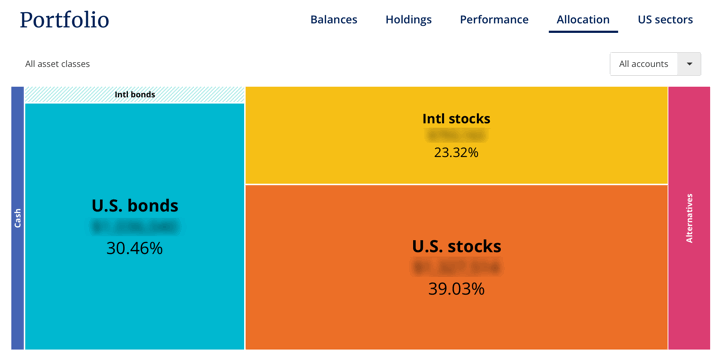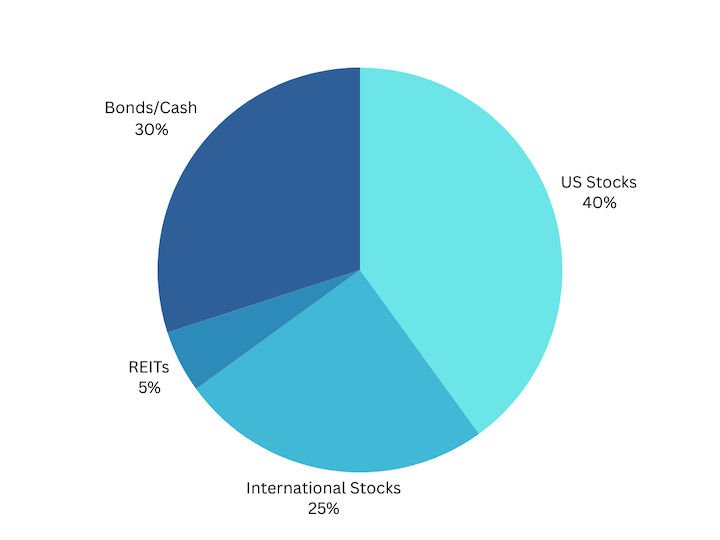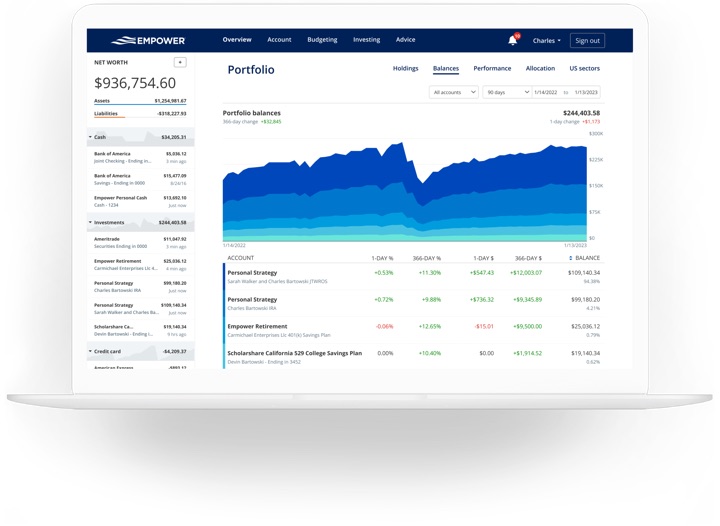Here’s my 2024 Q2 update for our primary investment holdings, including all of our combined 401k/403b/IRAs and taxable brokerage accounts but excluding our house and side portfolio of self-directed investments. Following the concept of skin in the game, the following is not a recommendation, but a sharing of our real-world, imperfect, low-cost, diversified DIY portfolio.
“Never ask anyone for their opinion, forecast, or recommendation. Just ask them what they have in their portfolio.” – Nassim Taleb
How I Track My Portfolio
Here’s how I track my portfolio across multiple brokers and account types. There are limited free advanced options after Morningstar discontinued free access to their portfolio tracker. I use both Empower Personal Dashboard (previously known as Personal Capital) and a custom Google Spreadsheet to track my investment holdings:
- The Empower Personal Dashboard real-time portfolio tracking tools (free) automatically logs into my different accounts, adds up my various balances, tracks my performance, and calculates my overall asset allocation daily. Formerly known as Personal Capital.
- Once a quarter, I also update my manual Google Spreadsheet (free to copy, instructions) because it helps me calculate how much I need in each asset class to rebalance back towards my target asset allocation. I also create a new tab each quarter, so I have a personal archive of my holdings dating back many years.
2024 Q2 Asset Allocation and YTD Performance
Here are updated performance and asset allocation charts, per the “Holdings” and “Allocation” tabs of my Empower Personal Dashboard.


I own broad, low-cost exposure to productive assets that will provide long-term returns above inflation, distribute income via dividends and interest, and finally offer some historical tendencies to balance each other out. I have faith in the long-term benefit of owning businesses worldwide, as well as the stability of high-quality US Treasury debt. My stock holdings roughly follow the total world market cap breakdown at roughly 60% US and 40% ex-US. I do add just a little “spice” to the broad funds with the inclusion of “small value” factor ETFs for US, Developed International, and Emerging Markets stocks as well as diversified real estate exposure through US REITs. But if you step back and look at the big picture, my target portfolio is quite boring.

By paying minimal costs including management fees, transaction spreads, and tax drag, I am trying to essentially guarantee myself above-average net performance over time.
The portfolio that you can hold onto through the tough times is the best one for you. Every asset class will eventually have a low period, and you must have strong faith during these periods to earn those historically high returns. You have to keep owning and buying more stocks through the stock market crashes. You have to maintain and even buy more rental properties during a housing crunch, etc. A good sign is that if prices drop, you’ll want to buy more of that asset instead of less. I don’t have strong faith in the long-term results of commodities, gold, or bitcoin – so I don’t own them.
I do not spend a lot of time backtesting various model portfolios, as I don’t think picking through the details of the recent past will necessarily create superior future returns. You’ll usually find that whatever model portfolio is popular at the moment just happens to hold the asset class that has been the hottest recently as well.
I have settled into a long-term target ratio of roughly 70% stocks and 30% bonds within our investment strategy of buy, hold, and occasionally rebalance. My goal has evolved to more of a “perpetual income portfolio” as opposed to a “build up a big stash and hope it lasts until I die” portfolio. My target withdrawal rate is 3% or less. Here is a round-number breakdown of my target asset allocation along with my primary ETF holding for each asset class. The reality is of course a bit more messy.
- 35% US Total Market (VTI)
- 5% US Small-Cap Value (VBR)
- 20% International Total Market (VXUS)
- 5% International Small-Cap Value (AVDV)
- 5% US Real Estate (REIT) (VNQ)
- 15% US “Regular” Treasury Bonds or FDIC-insured deposits
- 15% US Treasury Inflation-Protected Bonds (or I Savings Bonds)
Performance details. According to Empower, my portfolio is up about 6% so far in 2024. The S&P 500 is up about 14.5% YTD, while the US Bond index is down around 1%. I hold enough bonds and international stocks that I’m always going to be lagging the hottest sector, and I’m pretty much used to that now.
As usual, not much action. These quarterly updates are mostly for me to manually log into all my accounts to make sure they still exist. I didn’t sell a single share of anything. I did reinvest some dividends and interest to bring me back towards my target numbers. The US capital markets continue to reward the long-term investors who take on the risk of owning stocks.
I’ll share about more about the income aspect in a separate post.

 The Best Credit Card Bonus Offers – 2025
The Best Credit Card Bonus Offers – 2025 Big List of Free Stocks from Brokerage Apps
Big List of Free Stocks from Brokerage Apps Best Interest Rates on Cash - 2025
Best Interest Rates on Cash - 2025 Free Credit Scores x 3 + Free Credit Monitoring
Free Credit Scores x 3 + Free Credit Monitoring Best No Fee 0% APR Balance Transfer Offers
Best No Fee 0% APR Balance Transfer Offers Little-Known Cellular Data Plans That Can Save Big Money
Little-Known Cellular Data Plans That Can Save Big Money How To Haggle Your Cable or Direct TV Bill
How To Haggle Your Cable or Direct TV Bill Big List of Free Consumer Data Reports (Credit, Rent, Work)
Big List of Free Consumer Data Reports (Credit, Rent, Work)
I simply wait for you to change from VBR to AVUV. What’s stopped you so far?
New money is going into AVUV, but I have a lot of existing cap gains in VBR so I’m keeping it (unless there is a opportunity to offset). That’s what makes it the biggest holding. I switched more fully from VWO to AVDV/EYLD as there was not much cap gains there to worry about (sad face).
Thank you for sharing this. I am also heavier bonds and money market cash given the high (historically speaking) guaranteed returns. This strategy would have weathered the expected crash post Silicon Valley Bank until the Fed simply decided they weren’t going to let markets fail which won’t always happen. I still have FOMO but can sleep well at night.
I’m with you, have to balance the FOMO from the continued US stock market run with my desire for diversification. I just remind myself I don’t know that’s going to happen.
If you aren’t going to pick individual securities and dont need a ton of income, why not just be 100% equities?
Because I’ve been through crashes and panics and it is scary when they drop 50%. Stocks are the best bet, but they have also gone 20 years without a positive real return. I’d rather have a diversified setup that will withstand many different scenarios including my imperfect human emotions, rather than optimize for largest likely final value.
International stocks have been a HUGE disappointment, I wish I never bought them.
I agree, INTL holdings are horrible. Compare the 15 year chart of VGTSX and VOO. No surprise that US market has done better but look at the dips of the US stocks market and they coincide with INTL dips. Yes, I bought into the INTL diversification line a while ago but slowly selling off INTL now.
Jonathan,
Do you plan to continue to hold International stocks and such high allocation of bonds? Given that you guys still work part time and are probably out of the glidepath now, it seems that it would be better to be less conservative if you want to maximize long term wealth. You probably missed out on at least 3x gains over the last decade with your portfolio allocations.
If there are no bear markets (big if), I will probably let the stocks keep running and maintain my bond amount in absolute terms. At this point, the natural portfolio income has risen to a comfortable level and should hopefully keep going up. I definitely missed out on potential gains but was happy with the safety during this period of low earnings from work. Hindsight in 20/20, and my portfolio is still much bigger now, so I really can’t complain.
Agreed. Hindsight is always 20/20. I can’t help myself but to think that with the SP500 run the past decade+, even if it does drop 50% at some point in the future, I will still be better off than being too conservative. But you can’t win them all. I also remember the Great Financial Crisis and that definitely taught me a lesson being down 50% (though not much in absolute dollars) and panic sold some.
And a little side note while I have your attention, I’ve been following your blog and journey since 2006 right out of college with nothing to my name, to now with a family and pretty much FI. I attribute a big part due to finding your blog from the early days. Really learned a lot over the years. So thank you!! Anyway, just thought I’d let you know from a Internet reader/stranger.
Thanks for the kind words and well done on your own journey. It’s been quite a ride. I hope you are enjoying the fruits of your hard work and delayed gratification. The days are long but the years are short! 😎
Not sure if you’ll see this as I know I’m posting late, but Empower shows a big portion of my portfolio as “cash” when it’s really not. When I dig into it, it’s just small shares of various ETFs, etc. It’s driving me crazy because in reality I only keep about $20K of cash around – not the major portion they’re reporting. From your screenshot, it looks like you don’t have this problem (neither did I before Empower took over from PC). Do you have any idea how to fix it? Is there a setting I can toggle or something like that? Ideally I’d like to see my real asset allocation – not one inappropriately showing a big pile of cash that doesn’t exist (I can’t help but wonder if Empower does this to get customers to call in to get help reallocating all of that cash). Thanks!